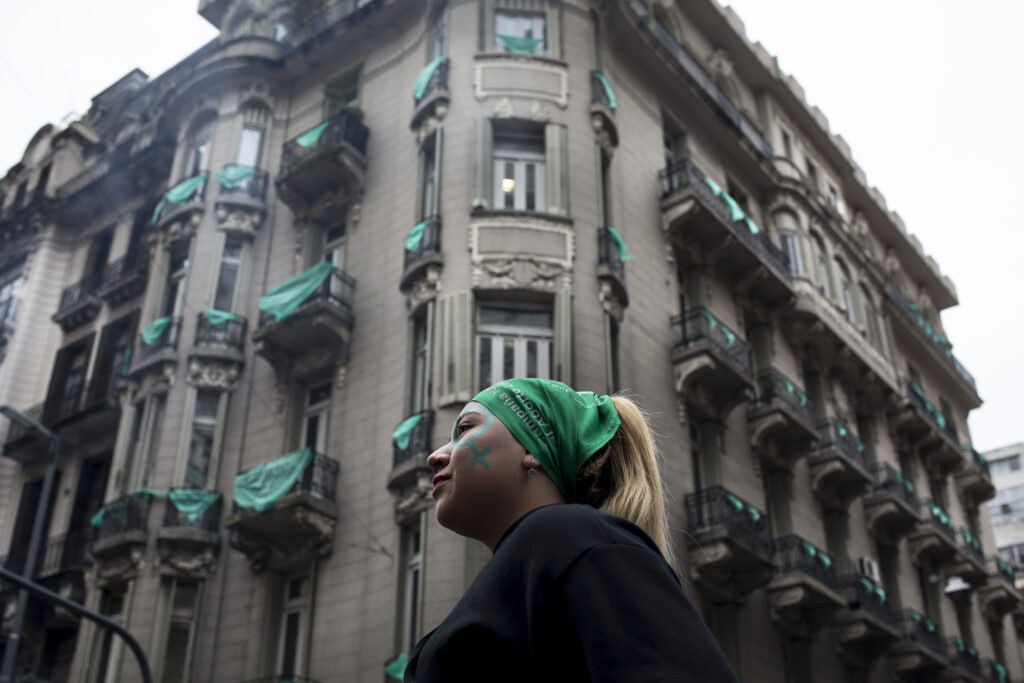
Five Abortion Strategies from the Argentinian Perspective
A Transnational Dialogue
January 18, 2023
Spectre would like to extend a special thanks to the photographers Vale Dranovsky and Lucía Prieto for letting us use their photos in this piece. Their work can be found on Instagram at @valedrano and @lucia.prieto.
Both the passage and overturning of Roe v. Wade marked historic moments not only for the United States, but also for the rest of the world. With people in the United States stripped of their constitutional right to abortion, now more than ever we must be on high alert and activate our international networks.
In the current context, the lessons from the Argentinian fight for abortion may be useful for U.S. activists. Here, I offer five strategies that local feminists and their allies deployed to build the movement for the legalization of abortion in Argentina, many of them reflecting transnational feminist experiences.
In December 2020, Argentina passed its Voluntary Interruption of Pregnancy Law (or IVE, its acronym in Spanish), legalizing abortion up until the fourteenth week of pregnancy. After the fourteenth week, access to abortion is allowed in cases of rape and risk to the health of the pregnant person. Before the law was approved, abortion was permitted only in such cases and only before the fourteenth week of pregnancy. It took years of activism and coalition building to win the current legislation and guarantee access to abortion. But today, Argentina and several Latin American countries can be examples of how to promote abortion legalization and effective access to safe abortion.
1. The creation of a national network for abortion legalization
One of the strongest elements of the feminist movement in Argentina was the creation of a national network for the legalization of abortion. The National Campaign for the Right to Legal, Safe, and Free Abortion, launched in 2003, is a multisectoral network of organizations and activists who, beyond their political differences, came together for a common goal. The objective was twofold. On the one hand, to present a bill for the legalization of abortion and achieve political support for its approval. On the other hand, to build a network of increasingly broad support in order to generate public consciousness and social consensus. To this day, the campaign works horizontally, with decisions made in open assemblies, elected representatives facilitating operations, and without any leaders of the movement.
2. An agreed discourse
From the beginning, campaign activists agreed on the arguments they were going to deploy to demand legalization. The agreed discourse posited that the legalization of abortion is necessary because it is a question of public health, social justice, and human rights. It is a matter public health because the criminalization of abortion affects parental and maternal morbidity and mortality rates, and public health indicators more broadly. It is a matter of social justice because while the richest always have access to safe abortions, even in legally restricted contexts, the poorest and most vulnerable are at higher risks of unsafe ones. It is a matter of human rights because making decisions about one’s own body is an inalienable individual right.
This discourse emerged not only out of the agreements come to by the campaign’s activists, but also out of the historical struggles for abortion in Argentina, shaped in and by the heat of fights against neoliberalism and social inequalities, hand in hand with human rights organizations, and with the important support of members of the public health field.1María Alicia Gutiérrez, “Rights and Social Struggle: The Experience of the National Campaign for the Right to Legal, Safe, and Free Abortion in Argentina,” in Abortion and Democracy (Routledge, 2021).
3. Building societal consensus
The most important strategy is that the campaign not only lobbied politically, but also pushed to build consensus at a societal level, what we call the “social decriminalization of abortion.” In Argentina, until a few years ago, it was not easy to talk publicly about abortion. The subject was, and to some extent continues to be, taboo, especially outside the big cities. In 2005, the campaign set out to socially decriminalize abortion. This was made possible through a unified discourse that sought to demystify abortion, to talk about it, and to argue solidly for its legalization through various networks, including political parties, unions, student groups, and grassroots community organizations. All these groups deployed strategies to forefront the issue as an urgent and necessary demand.
4. An appealing symbol
Early on, the campaign very opportunely chose a symbol: the green pañuelo or handkerchief/bandana. When the campaign was created, activists decided to use the pañuleo in honor of the Mothers of Plaza de Mayo, the mothers of those disappeared by the dictatorship between 1976 and 1983. Showing profound bravery and wearing white scarves on their heads to signal peaceful intentions, they confronted the military regime to demand information on their children and their safe return. Their appearance on the public scene left a deep mark on the role of women in resistance struggles in Argentina, Latin America, and beyond.
The pioneers of the abortion movement have different versions about why they chose the color green. Some say it was a color related to legalization that was not yet taken by other campaigns or groups, such as red, black, or white. Other pioneers say that when they went to buy fabrics during a National Women’s Meeting in 2004 it was available and seemed appropriate. Since then, the campaign has been distributing scarves at feminist marches, especially at the annual gatherings.
In 2018, when the legalization of abortion was first discussed in parliament there were abortion marches, and with them the green pañuelo, took on a mass character. The new generations were central, championing the green pañuelo as a sign of feminist struggle in a wider sense, which soon became transnational. Many Latin American countries took the idea of the pañuelo to represent the fight for legal abortion, and many of them chose the same green color, such as Colombia, Chile, and Mexico. The symbol continues to spread, now even to the United States.
5. Guaranteeing abortion access in a legally restricted context
Guaranteeing access to abortion is not only a matter of reproductive justice; it is also a way to combat the increasing social criminalization and to build social and institutional capacity. One important tool in safeguarding abortion access, in both restrictive and non-restrictive contexts, is medical abortion—that is, the use of mifepristone and misoprostol, or misoprostol alone in the absence of mifepristone. This is a safe method, requiring minimal supervision, according to the World Health Organization.2World Health Organization, Abortion Care Guideline (Geneva: World Health Organization, 2022).
Stubbornness, historically constructed as a flaw of those who disobey authority, can be reconceptualized and understood as an expression of resistance that can take us forward
A pioneering organization in medication abortion is the Dutch NGO Women on Waves. Since its inception, the organization has sought to “make waves” in countries where abortion is illegal. Its strategy is to anchor a ship in international waters near countries where abortion is criminalized, such as Portugal and Northern Ireland, and to provide medical abortions onboard to local people. Eventually, Women on Waves began to do what seems like a given today: to practice telemedicine. Through Women on Web, they advised people on safe abortions in chat rooms and sent the medications by mail.
The NGO later encouraged the launching of local groups in several countries, which, in turn, started to support one another.3Fernández Vázquez, Sandra Salomé and Lucila Szwarc, “Aborto Medicamentoso: Transferencias militantes y transnacionalización de saberes en Argentina y América Latina,” Revista De Ciencias Sociales y Humanas 12, no, 12 (2018): 163–77. In Argentina, Ecuador, and Chile, hotlines were set up to provide medication abortion information. In these countries, abortion was criminalized in most or all cases and no drugs were authorized for its purpose. However, misoprostol was available because it was legally authorized for other purposes, such as the treatment of stomach ulcers.
In 2013, the collective Lesbians and Feminists for Abortion Decriminalization was launched in Argentina to disseminate information on medical abortion through a hotline and website. It was possible to legally disseminate information about abortion without performing abortions in practice. The activists trained themselves, studying medical guidelines and disseminating information in clear, simple language. The collective also sought, as its name suggests, to “decriminalize” abortion in discourse, and brought the language of LGBTQ+ collectives into the abortion field. They refer, for example, to abortion “pride” and produced high-impact, eye-catching materials that sought to talk about abortion in everyday, light-hearted terms.4Ana Mines, Gabi Díaz Villa, Roxana Rueda, and Verónica Marzano, “‘El Aborto Lesbiano Que Se Hace Con La Mano.’ Continuidades y rupturas en la militancia por el derecho al aborto en Argentina (2009–2012),” Bagoas – Estudos Gays: Gêneros e Sexualidades 7, no. 9 (2013).
Later, the network Socorristas en Red was launched. The network was inspired by the experience of the Lesbians and Feminists for Abortion Decriminalization collective, but added a crucial element: face-to-face counseling. They followed the legacy of historical experiences of the 1970s in Europe and the United States, where nonprofessional feminists learned how to practice safe abortions without medical supervision. One important advantage they had was that medical abortion revolutionized access to quality abortion care. Medications are easier to transport and use, making the procedure outside of a clinic more autonomous and potentially safer for non-professionals. Medical abortion can be safely and effectively self-administered at home by individuals with accurate information and access to quality-assured pills.5World Health Organization, Abortion Care Guideline. Instead of distinguishing between safe and unsafe abortions, researchers now identify a continuum of possible safety or risks around the practice.6Bela Ganatra et al., “Global, Regional, and Subregional Classification of Abortions by Safety, 2010–14: Estimates from a Bayesian Hierarchical Model,” The Lancet 390, no. 10110 (2017): 2372–81.
The Socorristas activists meet with people seeking abortions to discuss how to use the pills in a safe way as well as to provide emotional support and accompany people through the process. They also had a hotline in case people had worries or concerns during the process, which they also used to encourage medical checkups after the abortion. Both the Socorristas and Lesbians and Feminists collected and still collect information about the calls they received. This is a crucial tool to demonstrate the usefulness of pharmacological abortions, accompanied by feminists, not only in political-feminist terms, but also in terms of public health.7Brianna Keefe-Oates, Chelsea G. Tejada, Ruth Zurbriggen, Belén Grosso, and Caitlin Gerdts, “Abortion Beyond 13 Weeks in Argentina: Healthcare Seeking Experiences During Self-Managed Abortion Accompanied by the Socorristas en Red,” Reproductive Health 19, no. 1 (2022): 185; Ruth Zurbriggen, Brianna Keefe-Oates, and Caitlin Gerdts, “Accompaniment of Second-Trimester Abortions: The Model of the Feminist Socorrista Network of Argentina,” Contraception 97, no. 2 (2018): 108–15. In turn, these experiences promote an autonomy-centered discourse, because safe abortion does not need to be necessarily mediated by a doctor.
At the same time, the Socorristas are in constant contact with healthcare professionals, who also make up one of the networks of the national campaign. The Health Professionals’ Network for the Right to Choose guaranteed access to abortion when it was still restricted. In the beginning, they followed a model of harm reduction to minimize the risks of unsafe abortion, providing information before and after the practice. They argued that, as healthcare professionals, they had the ethical duty to prevent a patient from taking unnecessary risks.
Over time they shifted their approach and started working under the “health clause,” or causal salud in Spanish, which offers a comprehensive care framework. This approach redefines “health” so that laws allowing abortion in cases where the health of the pregnant person is at risk also take into account mental and social well-being. This strategy started in Colombia, in a similar legal context to that of Argentina, before both legalization processes. In both countries, abortion was allowed in cases where the life of the pregnant person was at risk. Based on Argentina’s legal framework and international treaties, feminist lawyers stated that health is a comprehensive physical, social, and emotional state. Therefore, if a pregnancy threatens somebody’s well-being, a doctor could provide an abortion and be legally justified.
Over the years, more and more abortions were guaranteed under this policy. In fact, as a result of official public policy, cases in Argentina went from being called “nonpunishable abortions” to “legal terminations of pregnancy.” In Colombia, this strategy was achieved through the judicial route, promoted by feminists NGOs. More recently, this strategy allowed the Colombian Supreme Court to decriminalize abortion up to the twentieth week of pregnancy.
Conclusion
These five strategies help illuminate how guaranteeing abortion access in legally restricted contexts is crucial for promoting safe abortions and encouraging potential legal changes. The strategies I have described are not exclusive to the Argentinian context, but rather respond to transnational exchanges within feminists movements. A special feature of the Argentinian case is the persistence of its activists, who had been fighting for legal abortion for over thirty years, since the return of formal democracy. The legalization project was presented to Congress for discussion more than seven times and was rejected in the Senate before being resubmitted. As Nayla Vacarreza points out, citing Sara Ahmed, perhaps stubbornness, historically constructed as a flaw of those who disobey authority, can be reconceptualized and understood as an expression of resistance that can take us forward.8Nayla Luz Vacarezza, “La mano que vota. Visualidad y afectos en un símbolo transnacional del movimiento por el derecho al aborto en el Cono Sur,” Sexualidad, Salud y Sociedad (Rio de Janeiro) 35 (2020): 35–57.



